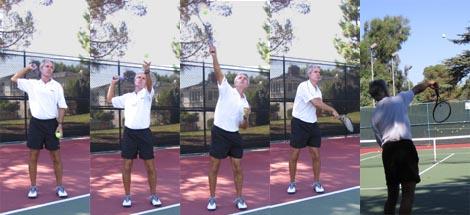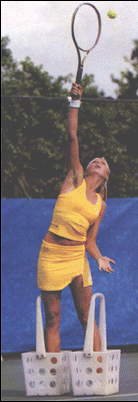Revolutionary Tennis |
||
Tennis Instruction That Makes Sense |
||
SERVE RACKET ACCELERATION DRILL You can increase your serve's power by isolating and practicing the forward acceleration part of the serve. The arms moving down and up, the body bowing and twisting, all merely offer rhythm and set-up for the acceleration area of the stroke. More rhythm and a better set-up can lead to more acceleration: rhythm should be simple, not complicated, and the set-up should avoid exaggeration. The acceleration part of the stroke occurs from the back-scratch position upward, the entire stroke services this moment. Yes, the racket is never stationary in that position, it drops down and then immediately goes up, the arm working like a spring, but it is the upswing where acceleration occurs. Objective: increase acceleration. Goal: hit the opposite fence on the fly from the baseline starting only from the back-scratch position and without taking a step or rotating much, if at all. Method: open your stance, bring the back foot around to simulate an open forehand groundstroke (protecting your shoulder since you will not be shifting body weight to assist), and place the racket behind you and down the back (the back-scratch position). Relax the wrist and arm. Toss the ball on the lower side and outside a bit, no need for a "perfect" toss here. Swing aggressively and try to hit a line drive to the back fence. Avoid any body distortion in order to maximize the arm's acceleration. I'm showing you how to do this below, and these photos, except the last one from behind, were done in succession (continuous shooting) and the ball did what it was supposed to. It surprised me how quiet and effortless I seem, but I am using my stomach muscles, my shoulder and arm muscles, and keeping the rest of me quiet for top acceleration.
You are practicing and reinforcing and improving what the arm does out of the back-scratch position with this drill. When you return to performing the entire serve muscle cognition (muscle memory anyone?) will kick in to your benefit. If you can't hit the back fence on the fly satisfy yourself with first hitting the ball beyond the baseline, then halfway between the baseline and the fence. Of course if you moon ball the drill you increase your chances of hitting the opposite fence, but that defeats the purpose. DON'T CHEAT Make sure you don't cheat on this drill. Cheating means: rotating your shoulder a lot so you're twisted over when done; lifting your back heel off the ground at the end; taking a step. Remain grounded, firm, knees flexed a bit, fire your ab muscles, flex the arm, snap the wrist. TENNIS magazine had a "Serve" issue, March, 2005. Pros Nick Saviano and Brenda Schultz-McCarthy's advice proved spot-on, but celebrity teacher Rick Macci's contribution on improving racket acceleration raised my eyebrows.
Rick further advises having your coach or friend toss the ball for you to help you speed up your racket, something about how putting you off your timing speeds up your racquet. I guess you're always going to need someone to help you...? I guess throwing you off your timing is a good thing...? Enough said. [Macci photos TENNIS, march, 2005, photos by Manuela Davies/PROPIX] |
||
|
|
||||||||||||||||||||||||||||||||||||||||||||||||||||||||||||||
 How many times? Just a few to start with, you'll notice your biceps enlarges, your arm tires. I wouldn't suggest doing this on successive days. Similar to weight lifting, practice at the most 3 times a week, skipping a day in between, and work your way up to 3 sets of 10 reps each. And you can do this against a practice wall just as well.
How many times? Just a few to start with, you'll notice your biceps enlarges, your arm tires. I wouldn't suggest doing this on successive days. Similar to weight lifting, practice at the most 3 times a week, skipping a day in between, and work your way up to 3 sets of 10 reps each. And you can do this against a practice wall just as well. Rick's idea of developing a "fast arm" (racket acceleration) are framed within a bigger picture of how to practice isolating the upper body on a serve in case you have an abdominal injury (don't even serve if you have an ab injury). He asks you to stand inside two ball hoppers to keep your legs quiet in order to force you to merely swing without taking a step. The photo on the right shows his student standing, sideways by the way, inside two empty plastic ball hoppers. Seems like a lot of trouble finding not only one hopper but two, and emptying them of tennis balls, and making sure they're plastic and not metal so you don't scratch the court when standing inside. But standing inside ball hoppers? They're small, and can trip you up. Are businesses immune to liability concerns in Florida? Open the stance, eliminate the hoppers, fire a line drive to the back fence. Keep it simple, and low tech.
Rick's idea of developing a "fast arm" (racket acceleration) are framed within a bigger picture of how to practice isolating the upper body on a serve in case you have an abdominal injury (don't even serve if you have an ab injury). He asks you to stand inside two ball hoppers to keep your legs quiet in order to force you to merely swing without taking a step. The photo on the right shows his student standing, sideways by the way, inside two empty plastic ball hoppers. Seems like a lot of trouble finding not only one hopper but two, and emptying them of tennis balls, and making sure they're plastic and not metal so you don't scratch the court when standing inside. But standing inside ball hoppers? They're small, and can trip you up. Are businesses immune to liability concerns in Florida? Open the stance, eliminate the hoppers, fire a line drive to the back fence. Keep it simple, and low tech.